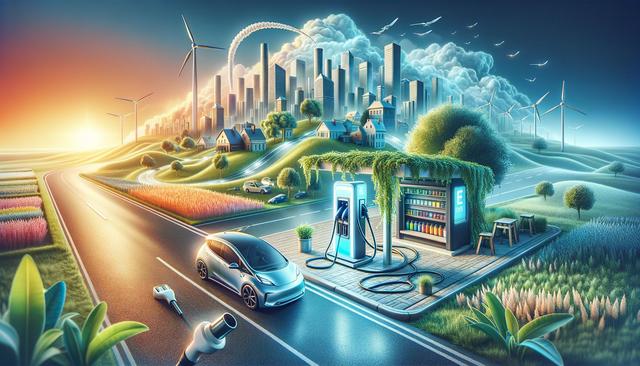Why More Drivers Are Embracing Electric Vehicles
More drivers are making the switch to electric vehicles, driven by a mix of practicality, innovation, and environmental awareness.

Environmental Benefits Are a Major Draw
One of the most compelling reasons drivers are switching to electric vehicles (EVs) is their significantly lower environmental impact compared to traditional gasoline-powered cars. EVs produce zero tailpipe emissions, helping to reduce air pollution in urban and rural areas alike. This is especially important as governments and communities prioritize cleaner air and a healthier environment for future generations. Additionally, as the energy grid becomes greener with increased reliance on solar, wind, and hydroelectric power, the overall carbon footprint of EVs continues to decrease.
EVs also contribute to reduced noise pollution. Electric motors operate more quietly than internal combustion engines, making for a more peaceful driving experience and less urban noise overall. For environmentally conscious consumers, these benefits align with long-term sustainability goals and offer a tangible way to reduce their personal impact on the planet.
Lower Operating and Maintenance Costs
Another notable reason for the shift toward EVs is the potential for lower operating and maintenance costs. Electricity is generally cheaper than gasoline, and EVs are more energy-efficient. This means that the cost per mile to drive an EV is often lower than that of a gas-powered vehicle. Over time, these savings can add up significantly for both daily commuters and long-distance drivers.
Maintenance is also simplified with EVs, largely due to their fewer moving parts. There’s no need for oil changes, fuel filters, spark plugs, or emission checks. Common maintenance tasks for EV owners typically include:
- Checking and rotating tires
- Replacing cabin air filters
- Monitoring battery health
- Occasional brake pad replacements (less frequent due to regenerative braking)
These factors make EVs an attractive option for budget-conscious drivers looking for long-term value.
Incentives and Government Support
Government policies and incentives are playing a significant role in encouraging the adoption of electric vehicles. Many countries and local regions offer financial incentives such as tax credits, rebates, reduced registration fees, and toll exemptions for EV buyers. These benefits can substantially lower the initial cost of purchasing an EV, making them more accessible to a wider range of consumers.
In addition to financial perks, some jurisdictions offer non-monetary incentives like access to carpool lanes, priority parking spots, and exemptions from certain driving restrictions. These added conveniences can make the day-to-day experience of owning an EV more appealing:
- Quicker commutes with HOV lane access
- Less time spent searching for parking in urban areas
- Reduced administrative hassle with simplified registration
As policies continue to evolve in favor of cleaner transportation, these incentives are likely to expand, further driving EV adoption.
Improving Technology and Performance
Technological advancements have significantly improved the performance and appeal of modern electric vehicles. Today’s EVs offer enhanced driving ranges, faster acceleration, and a variety of comfort and safety features that rival or surpass those of traditional cars. Battery technology has seen major progress, with many models now capable of traveling over 250 miles on a single charge, addressing one of the early concerns about range anxiety.
Charging infrastructure is also developing rapidly. Public charging stations are becoming more common, and fast-charging options can replenish a significant portion of a battery’s capacity in under an hour. Home charging solutions add another layer of convenience, allowing owners to recharge overnight and start their day with a full battery.
Key tech features that enhance the driving experience include:
- Advanced driver-assistance systems (ADAS)
- Over-the-air software updates
- Customizable driving modes
- Smartphone integration and connectivity
These innovations make EVs not just an environmentally friendly choice, but also a technologically forward one.
Changing Consumer Preferences and Cultural Shifts
Beyond practical and environmental considerations, cultural attitudes toward transportation are also evolving. Consumers are increasingly prioritizing sustainability, innovation, and efficiency in their purchasing decisions. This shift is particularly evident among younger drivers, who are more likely to value the climate impact of their choices and embrace new technologies.
Social awareness campaigns, media coverage, and peer influence have contributed to a growing acceptance and enthusiasm for electric vehicles. As EVs become more visible on the roads and in everyday conversations, they are shedding their once-niche status and entering the mainstream.
Furthermore, auto manufacturers are responding to these changing preferences by expanding their EV offerings across various price points and styles, including:
- Compact city cars
- Family-friendly SUVs
- Luxury sedans
- Performance-oriented sports models
This variety ensures that more consumers can find an EV that suits their needs and lifestyle, further accelerating the transition away from internal combustion engines.
Conclusion: The Road Ahead for EV Adoption
As more drivers evaluate their transportation choices through the lens of cost, convenience, and environmental impact, electric vehicles are becoming an increasingly attractive option. The combination of reduced emissions, lower maintenance costs, supportive government policies, improved technology, and shifting consumer values is creating strong momentum toward EV adoption.
For individuals considering their next vehicle purchase, exploring electric options may offer a forward-looking solution that aligns with both personal values and practical needs. The road ahead for EVs looks promising, and their growing presence on our streets is a sign of a broader shift in how we think about mobility, sustainability, and innovation.